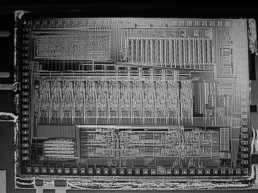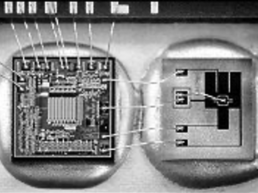Specialized wire bonding and die bonding solutions
About Die Bonding
Added material compatibility with a range of substrates and die materials
Precise process control plays a crucial role in component assembly
Die Bonding, also known as die attach, is a process used to attach a die or chip to a substrate, chip carrier, housing or package. Die attach can be achieved through various methods including eutectic bonding, adhesive bonding, and glass or silver-glass bonding.

Eutectic Bonding
Eutectic Bonding involves soldering a chip in place by melting a thin, pre-cut solder piece, called a preform, between the die and substrate. The preferred preform does not contain lead and consists of a mixture of alloy or different metals, which when combined in a specific ratio, have a lower melting point than the individual base materials that make up the alloy. Eutectic Bonding allows for bonding at temperatures that will not damage heat-resistant die/chips and offers good thermal conductivity, electrical conductivity, fatigue/creep resistance, and low contamination. However, it does require high processing temperatures and the use of inert gas to prevent oxidation.
Typical preform materials and melting points:

With a typical preform composed of gold and silicon (gold melting point 1640° C and silicon melting point of 1414°C) the combined preform materials melting point becomes 363° C.
- 97Au-3Si
- 88Au-12Sn
- 80Au-20Sn
- 82Au-18In
- 363ºC
- 350ºC
- 280ºC
- 451 oC
In the eutectic process, the preform first, then the chip/die are placed by the Eutectic Die Bonder on the substrate which is secured to a heated work stage operating just below the eutectic melting point. The light scrubbing action on the bond head generates enough energy to raise the temperature at the target site above the eutectic melting point. When scrubbing ceases, the melted material solidifies creating the bond.
The HYBOND UDB-141 semi-automatic Eutectic Die Bonder and UDB-206B Manual Eutectic Die Bonder are designed for these types of applications.
Adhesive Bonding
Adhesive Bonding relies on adhesive materials to secure the die to the substrate. It can be conducted at room temperature and depending on the adhesive can be electrically conductive or insulating. Adhesive bonding offers advantages like low curing temperatures, reduced die stresses and the ability to bond a wide range of die sizes. However, adhesive bonding has drawbacks like outgassing, contamination/bleed, inferior thermal/electrical conductivity, dimensional changes during processing and sensitivity to harsh environments.

- Acrylic thermoplastic resins
- Epoxy thermo-set resins
- Silicone resins
In the adhesive bonding process, the substrate or package is secured to an unheated work stage. Adhesive material is contained in a reservoir and dispensed in a small amount onto the substrate in a die-sized pattern. The bonder then picks up and places the die on the adhesive pattern enabling the bond. The bond process is complete once the adhesive dries or is cured in an oven.
The HYBOND EDB-140A and EDB-141 semi-automatic epoxy die bonders are well suited for adhesive applications.
Glass or Silver-Glass Bonding
Glass or Silver-Glass Bonding involves using glass paste, sometimes containing silver particles, to bond the die to the substrate. Like Adhesive Bonding, instead heating a glass paste (350ª – 450º C) to create a low viscosity liquid that solidifies upon cooling, forming the bond. Glass Bonding offers advantages such as being relatively insensitive to metallization, low void content, good thermal and electrical conductivity, limited stress relaxation, low contamination, and high process/operating temperature resistance. However, high processing temperatures needed for Glass Bonding can cause oxidation.

